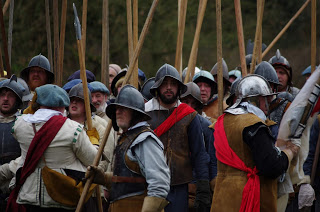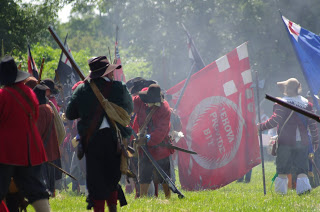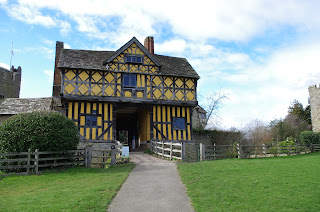Army of the Covenant: More Command
Just as Montrose's army has had some more command figures, so have the Covenanters. These are from Peter Pig Scots generals pack 40. All three have had headswaps.
Sir Alexander Hamilton
Hamilton was the Covenanter general of artillery until 1649 when he died. Known to friend and foe as 'dear Sandy' he fought for both Denmark and Sweden. It is believed that he may have refined the Swedish leather gun, but he is best known for inventing the 'Dear Sandy Stoups' - four light bronze barrels mounted upon a frame.
John Campbell, 1st Earl of Loudoun
Loudoun was more of a politician than a soldier, despite being the colonel of regiments of foot and horse. A leading light in the Covenanter cause, he was one of the commissioners sent to London to negotiate with the King after the First Bishops War. Appointed Lord Chancellor of Scotland in 1641, in a vain attempt by Charles to win Loudoun's loyalty; his loyalty was with the Solemn League.
 |
Loudoun was more of a politician than a soldier, despite being the colonel of regiments of foot and horse. A leading light in the Covenanter cause, he was one of the commissioners sent to London to negotiate with the King after the First Bishops War. Appointed Lord Chancellor of Scotland in 1641, in a vain attempt by Charles to win Loudoun's loyalty; his loyalty was with the Solemn League.
He would venture south again: to negotiate the alliance with Parliament in 1643, and to negotiate the failed Treaty of Uxbridge in 1645.
Loudoun would throw his hat behind the Engager movement, having negotiated with Charles at Hampton Court in 1647. He would become disillusioned with the Engagers and he aligned himself with the hard-line Covenanters of the Kirk Party.
Loudoun would exist relatively quietly during the Commonwealth despite his opposition to Cromwell (he would eventually submit his loyalty to Monck in 1655). Despite surrendering his positions and paying a fine for his support for the Covenanters he died peacefully in Edinburgh in 1662.
 |
| He has been dusted since the photo was taken. |
Loudoun would throw his hat behind the Engager movement, having negotiated with Charles at Hampton Court in 1647. He would become disillusioned with the Engagers and he aligned himself with the hard-line Covenanters of the Kirk Party.
 |
Archibald Campbell, 1st Marquis of Argyll
In 1638 Charles I tried to enlist Archibald's support for his religous reforms, which Archibald strongly advised the King against. This drove Archibald to side with the Covenanters. During the Bishops' wars Argyll secured Scotland for the Covenant, suppressing Royalist support, whilst Leslie marched south.
Fast forward to 1641, England is on the verge of Civil War, Charles heads north and tries to secure Archibald's loyalty (and as a consequence Scotland) by creating him the Marquis of Argyll. Argyll sends troops to Ireland to suppress the Irish Catholic rebels.
Civil war has now broken out in England, and the Scottish Parliament debates how best to spread Presbyterianism influence south of the border: will King or Parliament support Presbyterianism and the Covenanter cause? Argyll was dominant in the Scottish Parliament, and almost certainly helped sway the Scots to ally with Parliament and sign the Solemn League and Covenant in 1643.
Whilst this seemingly principled approach to which cause he would fight for, Argyll also had a few personal scores to settle. He and Montrose had become bitter enemies, an animosity that started during the Bishops' Wars. Montrose's nucleus of his Scottish troops were MacDonalds, sworn enemies of Argyll's clan the Campbells. Montrose's men would slaughter 1500 Campbells at Inverlochy. Argyll would seek revenge after Philiphaugh by ordering that all MacDonalds who had surrendered should be put to the sword.
Argyll would travel south to negotiate peace with Charles and Parliament; Charles would negotiate an alliance with the Scots (Engagers), but Argyll would not support the Engager movement. He would continue to side with the Covenant and Cromwell.
During the Commonwealth he would witness Montrose's execution, then retreat to his lands. He would not support the invasion of England (that would culminate in the Battle of Worcester).
Argyll's son would not share his father's views and was involved in the Glencairn's Uprising, which led Argyll to request government troops to protect him from his own son.
By the time of the Restoration Argyll would try to negotiate a reconciliation with Charles II: he was immediately thrown into the Tower of London as a prisoner. He would be tried and found guilty of treason, being sentenced to death and beheaded on 27 May 1661. His head was fixed to the same spike at the Edinburgh Tollbooth.
If you enjoyed reading this, or any of the other posts, please consider supporting the blog.
Thanks.







.jfif)





Comments
Post a Comment